Precisionism: The Art of Clean Lines and Modern Times
Author:
GeorgeUpdated:
01.02.2025


- Key Takeaways
- What Is Precisionism?
- The History of Precisionism
- 1.Why Was Precisionism So Important?
- 2.What Happened to Precisionism?
- 1.
- What Makes Precisionism Unique?
- 8 Artists Who Defined Precisionism
- 3.Joseph Stella: Brooklyn Bridge
- 4.Elsie Driggs: Pittsburgh
- 5.Ralston Crawford: Whitney Elevator
- 6.Charles Demuth: I Saw the Figure 5 in Gold
- 7.Charles Sheeler: American Landscape
- 8.Georgia O’Keeffe: The Shelton with Sunspots
- 9.Louis Lozowick: Brooklyn Bridge
- 10.George Ault: Bright Light at Russell’s Corners
- 3.
- Precisionism Today: Why It Still Matters
Art often celebrates the natural world, but what about the sharp edges and purposeful lines of the industrial age? Can factories, machines, and skyscrapers hold the same beauty as mountains and rivers? Precisionism, an art movement from the early 20th century, answered this question with a resounding yes, finding poetry in the overlooked structures of modern life.
As artist Charles Demuth once said,
“I seek to capture the essence of American life, to find the poetry in the everyday objects and structures that surround us.”
Precisionism could turn the ordinary into art, celebrate clean lines, geometric forms, and the power of modern architecture.
Through the eyes of Precisionist artists like Demuth and Charles Sheeler, the industrial world became a subject of beauty, reminding us that art is not just about nature or abstraction—it’s about seeing the extraordinary in the everyday.
Key Takeaways
Precisionism was America’s first modern art movement, celebrating the clean lines and geometric beauty of factories, bridges, skyscrapers, and other industrial structures.
Inspired by European movements like Cubism and Futurism but developed a uniquely American identity that reflected national pride in progress and industrial growth.
Precisionism emerged in early 20th-century America, during a time of rapid urbanization and industrialization.
It challenged traditional art by celebrating man-made structures and industrial progress, finding beauty in modernity
Its impact extended to later movements like Pop Art and Minimalism, which similarly celebrated everyday objects and simplicity.
What Is Precisionism?
Precisionism, often called America’s first modern art movement, began in the early 20th century during a time when factories, cities, and machines were transforming the world. This movement mixes realistic details with a modern style that simplifies shapes. Precisionism celebrates the sharp, geometric look of the modern world—factories, bridges, skyscrapers, and even barns and silos. This art shows them in a clean, organized, and almost perfect way.
The style is known for its smooth, polished surfaces and sharp, straight lines. Precisionist artists avoided messy brushstrokes. That makes their paintings look sleek and controlled. They also rarely included people in their work. They are focusing on the buildings and machines to tell the story of progress and change on their own.
Precisionism was inspired by European art movements like Cubism, which focused on breaking objects into simple shapes. It also was inspired by Futurism, which celebrated the energy of machines and technology. However American artists made Precisionism their own. They created art that reflected pride and excitement about the country’s growth and modern achievements. This movement invites us to pause and see the artistry hidden in the structures that shape our modern lives. For example, geometric art, with its clean, calculated forms, aligns closely with the ideas celebrated by Precisionists.
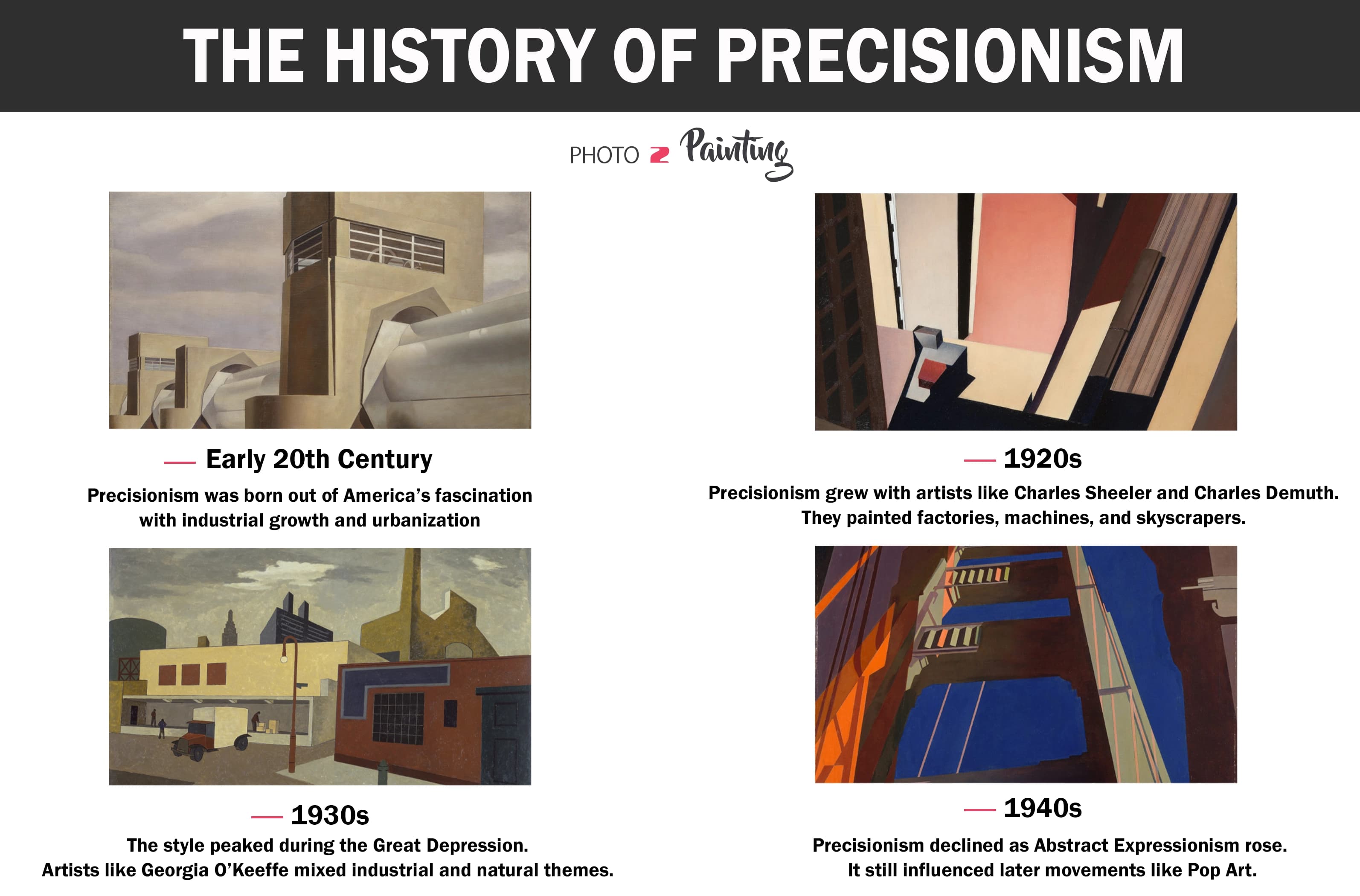
The History of Precisionism
Precisionism, one of many art types, emerged in early 20th-century America, a period defined by booming cities, thriving factories, and groundbreaking technological advances. As the nation embraced industrialization and urbanization, artists sought to capture the sleek, geometric beauty of the modern world. By the 1910s and 1920s, Precisionism had gained popularity, focusing on structures like skyscrapers, bridges, and machines that symbolized progress and innovation.
This movement resonated with the optimism of the time. America was rising as a global industrial power, and Precisionist art reflected the pride many felt in the nation’s growth. Artists emphasized clean lines, bold geometric forms, and the orderly beauty of industrialization, transforming everyday structures into symbols of modern life’s potential.
Artists like Charles Sheeler and Demuth found inspiration in these man-made structures, much like today’s creators might explore spiritual art to convey deeper meanings.
Key moments in the history of Precisionism are below.
- Early 20th Century: Precisionism was born out of America’s fascination with industrial growth and urbanization.
- 1910s–1920s: The movement reached its peak as artists like Charles Demuth and Charles Sheeler turned industrial landscapes into art.
- Cultural Mood: The style reflected the optimism and pride of America’s rapid transformation during the industrial age.
Why Was Precisionism So Important?
Precisionism was important because it redefined what could be considered art. It celebrates the man-made world as a source of beauty and inspiration. By focusing on factories, machinery, and skyscrapers, artists like Charles Demuth and Charles Sheeler showed that industrial progress could evoke as much awe as traditional art subjects like landscapes or portraits.
One of the movement’s defining contributions was its role in shaping modern American art. At a time when much of the art world looked to Europe for inspiration, Precisionism created a uniquely American style. Just as traditional art reflects its era, Precisionism highlighted America’s industrial strength. Paintings like Charles Demuth’s "My Egypt" and Charles Sheeler’s "American Landscape" captured the nation’s industrial strength and optimism. It defines an artistic identity rooted in progress and innovation.
What Happened to Precisionism?
By the 1940s, Precisionism began to fade as the world faced new challenges. The optimism and pride that had fueled the movement were replaced by the uncertainty of World War II and its aftermath. New art movements like Abstract Expressionism emerged, focusing on raw emotion and spontaneity. Abstract Expressionism contrasted sharply with Precisionism’s controlled, structured aesthetic.
Despite its decline, Precisionism left a lasting legacy. It influenced later movements like Pop Art, which found beauty in everyday objects. It also influenced Minimalism, which embraced simplicity and clean lines. Precisionism’s ability to transform the industrial world into a source of artistic inspiration continues to be admired. It reminds us to see the beauty in the structures that shape our lives.
What Makes Precisionism Unique?
Precisionism is a one-of-a-kind art movement that showed the beauty of the industrial world. Instead of focusing on nature or abstract ideas, Precisionist artists used clean lines, geometric shapes, and smooth surfaces to highlight factories, skyscrapers, and other man-made structures. This bold approach celebrated modern life and showed that even everyday objects could be artistic.
Clean Lines and Geometric Shapes
Precisionism is known for its sharp lines and geometric shapes. Artists avoided extra details. They focus on the simple, sleek forms of buildings, bridges, and machines. Their work often looked polished and modern, almost like a perfect version of real life.
A Focus on the Industrial World
Precisionist artists celebrated factories, skyscrapers, and other industrial structures. These subjects symbolized progress, technology, and the excitement of the modern age. Works like Charles Demuth’s ‘My Egypt’ and Charles Sheeler’s ‘American Landscape’ turned everyday objects into striking works of art.
A Blend of Realism and Abstraction
Precisionism blended realistic subjects with abstract, simplified designs. Artists removed unnecessary details, focusing on the essential shapes and forms of their subjects. This mix made their work feel timeless and dreamlike.It balances reality with imagination.
Redefining Beauty
Precisionism showed that beauty could be found in the industrial world. The movement challenged traditional art by celebrating modern structures instead of nature or people. Its influence can still be seen in movements like Minimalism and Pop Art, which also focused on finding artistry in everyday objects.
8 Artists Who Defined Precisionism
Precisionism came to life through the work of several key artists who celebrated the beauty of modern structures like factories, skyscrapers, and bridges. These artists used their unique styles to turn the industrial world into something inspiring and artistic. Here are some of the most famous Precisionists and their iconic works.
Joseph Stella: Brooklyn Bridge
Joseph Stella’s Brooklyn Bridge is one of the most famous works of Precisionism. In this painting, Stella used bold lines and bright light to show the power of the bridge. The cables and the glowing lights make the bridge feel alive. It captures the energy of New York City. The painting shows the bridge not just as an engineering marvel, but as a symbol of the modern world.
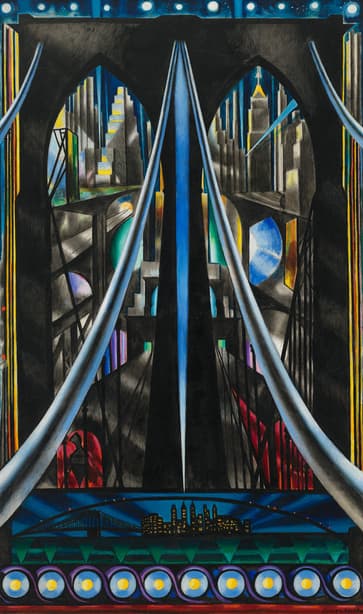
Stella’s use of light and shadow makes the structure feel dynamic, as if it is in motion, reflecting the fast pace of the city. If this inspires you, consider exploring canvas painting ideas to bring modern structures to life in your own artwork.
Elsie Driggs: Pittsburgh
Elsie Driggs’ Pittsburgh shows a steel factory as a powerful, almost majestic structure. With simple forms and soft colors, she turned an industrial scene into something beautiful and orderly. Similarly, experimenting with acrylic painting techniques can help you achieve soft yet powerful visuals in your art.
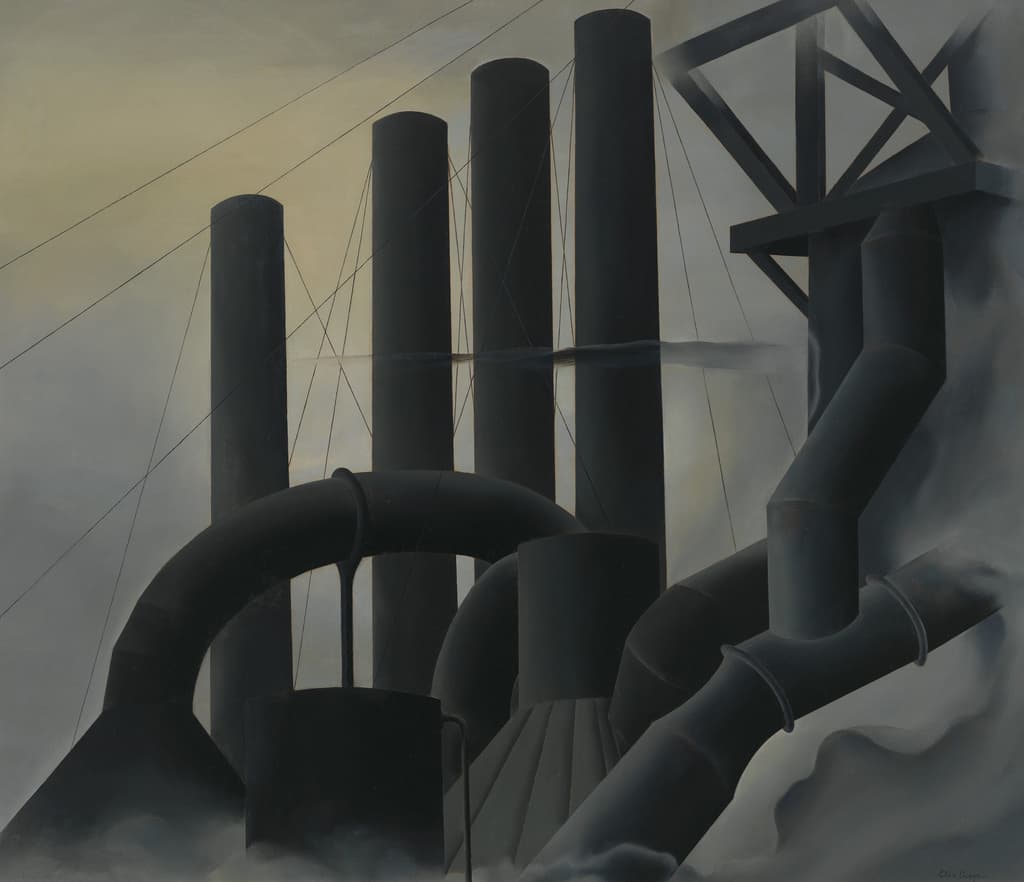
Driggs focused on the shapes and size of the factory. She showed how important it was to the modern world. Her painting reminds us that even factories, which people often see as dirty or boring, can have a kind of beauty. The factory looks strong and solid, which makes it feel like a symbol of progress and strength.
Ralston Crawford: Whitney Elevator
Ralston Crawford’s Whitney Elevator is a great example of Precisionism’s focus on industrial design. The painting shows a tall grain elevator, with sharp, clean lines and a clear sky in the background. Crawford turned the elevator into a geometric shape, making it look like a work of art.

The painting shows how even everyday structures like elevators can be beautiful when viewed through an artistic lens. The bright sky makes the elevator stand out, almost making it look larger than life and full of purpose.
Charles Demuth: I Saw the Figure 5 in Gold
Charles Demuth’s I Saw the Figure 5 in Gold is one of the most famous paintings of the Precisionist movement. Inspired by a poem by his friend William Carlos Williams, the painting features the number "5" in gold and red, surrounded by sharp, overlapping shapes.
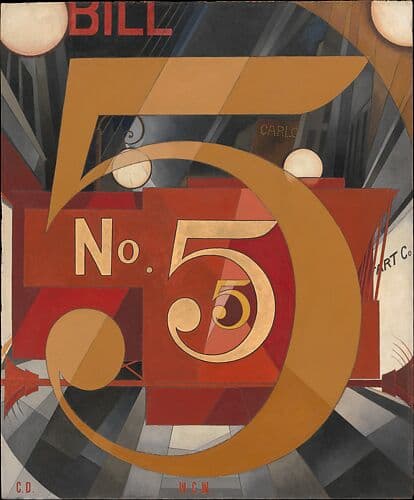
The painting shows the energy of a firetruck rushing through the city. The bright colors and clear lines help us feel the movement and speed, almost like we’re right there on the street watching the action unfold. Demuth uses numbers and shapes to capture the pulse of the city in a way that’s both artistic and full of life.
Charles Sheeler: American Landscape
Charles Sheeler’s American Landscape shows a Ford Motor Company factory. He focused on the factory’s clean, sharp lines and organized structure. Sheeler left out people in the painting, so we focus only on the shapes and forms of the factory, which looks almost perfect.
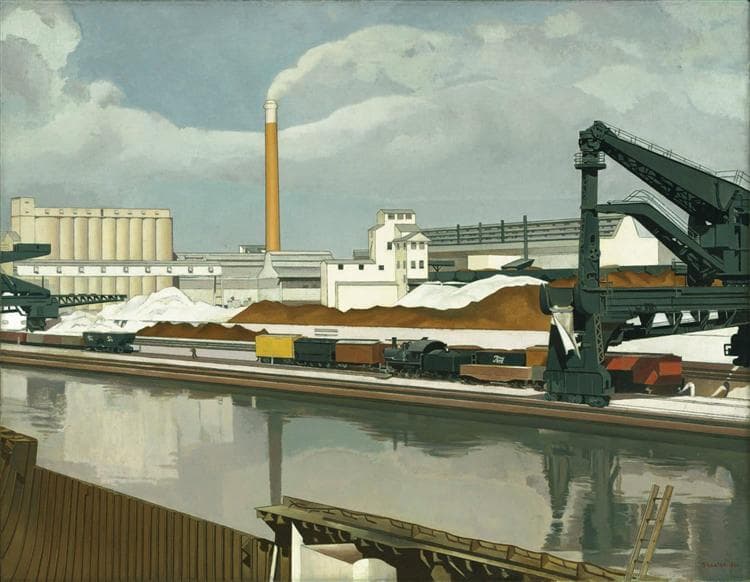
The painting shows how factories and machines can be symbols of progress and modernity. Sheeler’s work is a clear example of how Precisionism turned everyday industrial scenes into beautiful works of art.
Georgia O’Keeffe: The Shelton with Sunspots
Georgia O’Keeffe’s The Shelton with Sunspots shows a skyscraper she saw from her apartment. The building’s sharp, geometric lines are softened by the warm sunlight that surrounds it, making the scene feel peaceful and inviting. O’Keeffe used light and color to give the building a sense of life and warmth, which isn’t always seen in typical Precisionist art.
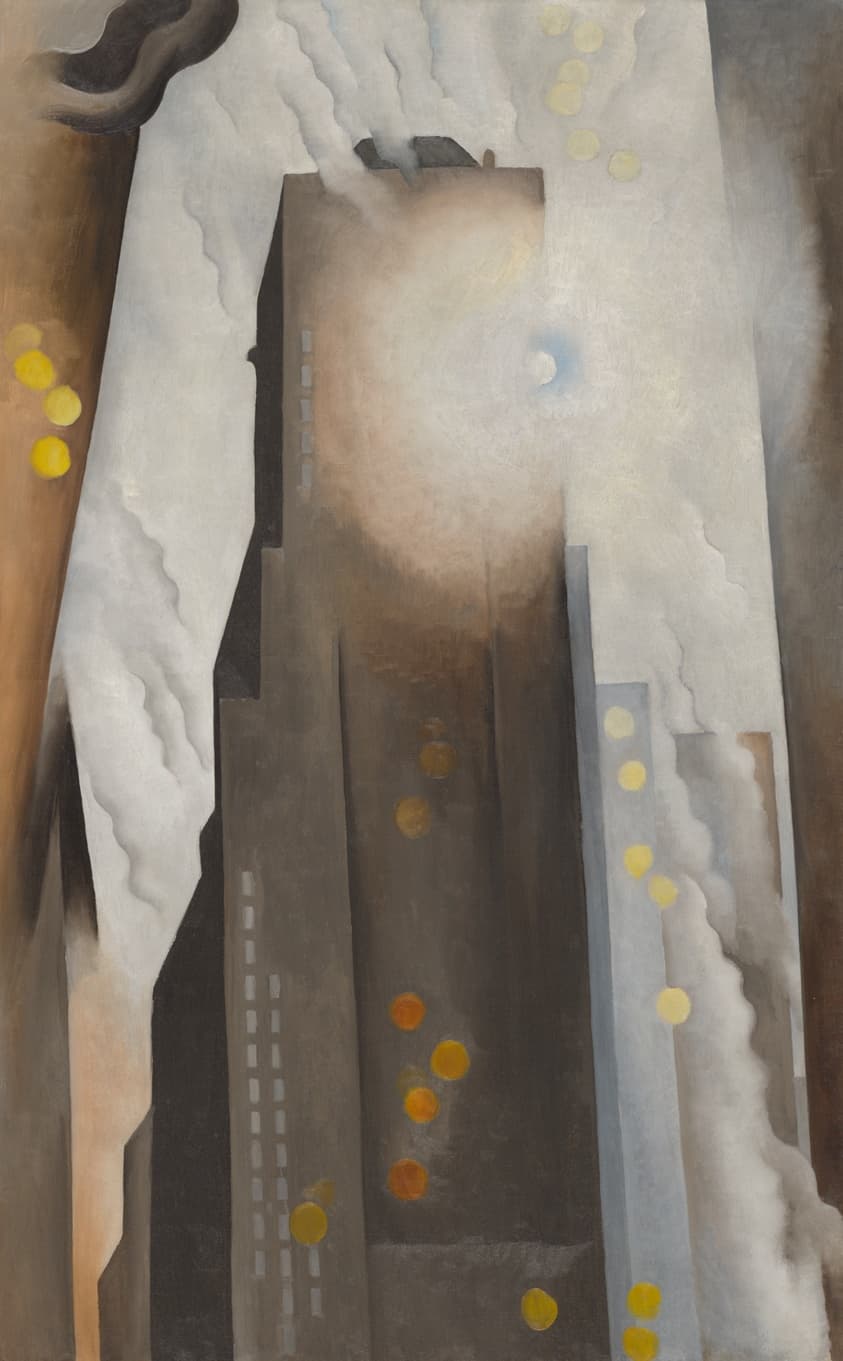
This painting shows how O’Keeffe blended the sharp lines of Precisionism with her own softer, more emotional style. Similarly seen in romantic paintings.
Louis Lozowick: Brooklyn Bridge
Louis Lozowick’s Brooklyn Bridge focuses on the bridge’s sharp, geometric design. He turned the bridge into a beautiful and powerful symbol of modern engineering. In this painting, Lozowick simplifies the bridge into clear, strong shapes, showing how industrial architecture can be as artistic as nature.
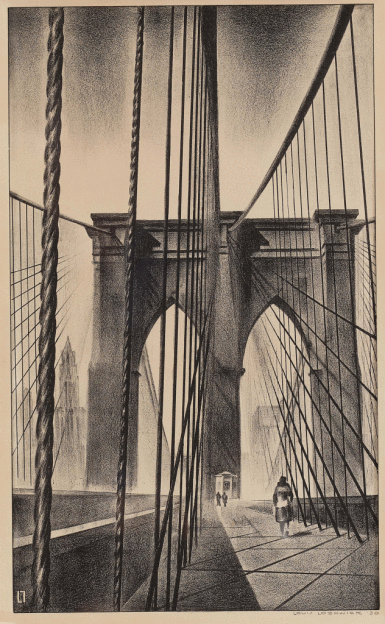
The bold lines and the soft, glowing light around the bridge give it a feeling of strength and movement. It shows how a simple structure can tell a bigger story about the modern world.
George Ault: Bright Light at Russell’s Corners
George Ault’s Bright Light at Russell’s Corners captures a quiet, rural intersection at night. Unlike many Precisionist works that focus on cities, Ault shows how even small, simple places can have beauty. The dark painting’s crisp lines and glowing street lights make the scene feel peaceful and still, yet it has a sense of mystery and importance.
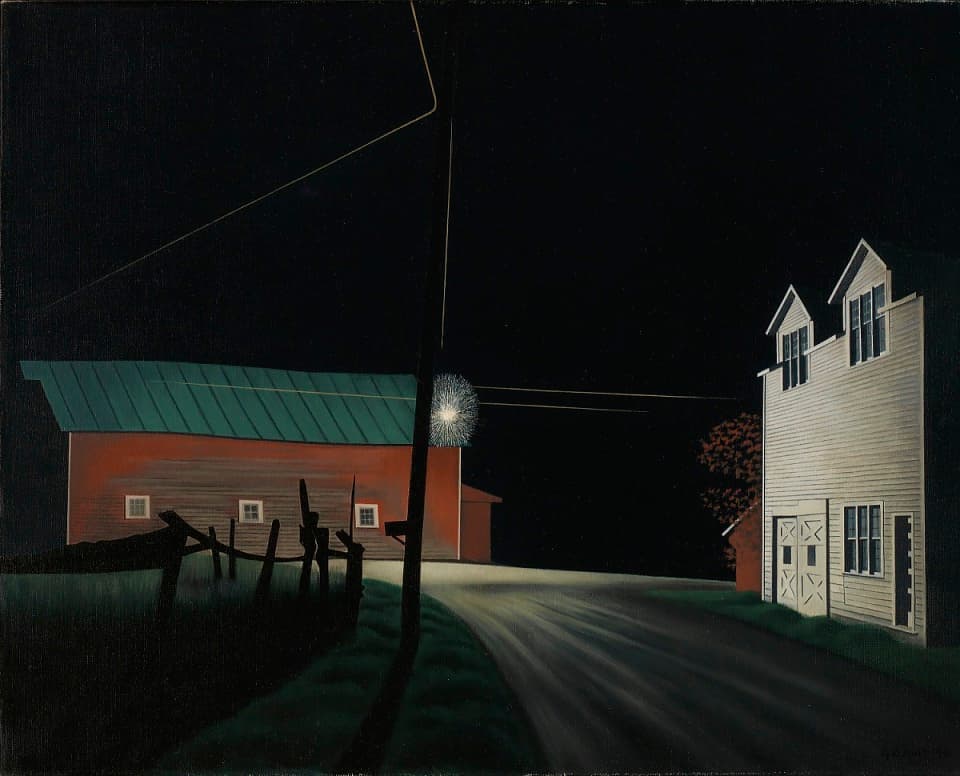
This work shows that Precisionism could also be about finding clarity and order in quieter, everyday moments, not just the busy industrial world.
Precisionism Today: Why It Still Matters
Even though Precisionism was most popular in the early 20th century, its themes still matter today. The movement focused on machines, factories, and the urban environment, which are still important in our modern world. As technology and cities continue to grow, Precisionism reminds us of the power and beauty in the industrial world. The clean lines and geometric shapes seen in the artwork of Precisionists can still be seen in today’s architecture, design, and even the way technology shapes our cities. It continues to inspire contemporary types of painting styles. The movement shows us that modern life, with all its buildings, factories, and machines, can be just as inspiring as nature.
If you want to explore Precisionist art today, there are many places where you can see it. Some famous museums, like the Smithsonian American Art Museum and the Metropolitan Museum of Art, have collections that include works from key Precisionist artists. You can also find exhibitions that showcase these artists in cities across the country. Additionally, many museums offer online galleries where you can view the artwork from the comfort of your home. Precisionism’s influence continues to shape how we look at modern architecture, technology, and art today.
Conclusion
Precisionism was an important movement in American art that helped shape how we see modern life. Through its focus on clean lines, geometric shapes, and industrial scenes, it showed us the world around us. From factories to skyscrapers, Precisionism showed us that they can be beautiful and meaningful.
As Charles Sheeler once said,
"I am fascinated by the beauty of the machine age, by the power and precision of industrial forms."
This quote reflects the heart of Precisionism—finding beauty in the machines and structures that are often overlooked.
Even today, the ideas and style of Precisionism still influence how we think about technology, cities, and modern design. It reminds us to appreciate the power and artistry of the world we live in. Whether through architecture, art, or everyday objects, Precisionism continues to inspire us to see the beauty in the industrial world around us.
Frequently Asked Questions
What is the meaning of Precisionist?
A Precisionist is an artist who creates artwork with sharp lines, clear shapes, and smooth surfaces. Their work often focuses on buildings, machines, and factories, showing these subjects in a clean, organized, and almost perfect way.
Which European movement was influential on Precisionism?
Precisionism was influenced by European art movements like Cubism and Futurism. Cubism focused on breaking objects into geometric shapes, while Futurism celebrated speed, technology, and modern life. Precisionists combined these ideas to create art that highlighted the beauty of industrial and urban scenes.
What are the techniques of Precisionism?
Precisionists used straight lines, clear shapes, and smooth, flat colors to make their work look clean and polished. They avoided visible brushstrokes and often simplified objects like buildings and machines to focus on their geometric qualities. This approach made their art look modern and precise.
What is precision in art?
Precision in art means creating something that looks very exact, detailed, and clear. Artists who focus on precision aim for clean lines and smooth surfaces, making their work look neat and well-defined.
Was Charles Sheeler a Precisionist?
Yes, Charles Sheeler was a well-known Precisionist. He painted and photographed industrial scenes, like factories and cityscapes, and his work celebrated the modern world’s technology and structure. He is considered one of the key artists of the Precisionist movement.
What time frame was Precisionism?
Precisionism was most popular from the 1910s to the 1940s. This period reflected America’s growing excitement about industrialization, machines, and modern cities. The movement captured the spirit of the early 20th century.
George, CEO of Photo2painting, is a passionate art lover and entrepreneur. He founded Photo2painting.com from scratch, inspired by his artist friends. As the company's CMO, he manages content and marketing.
Excellent Customer Reviews















































































































































